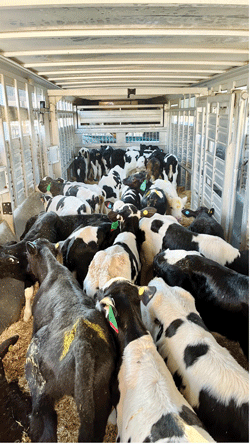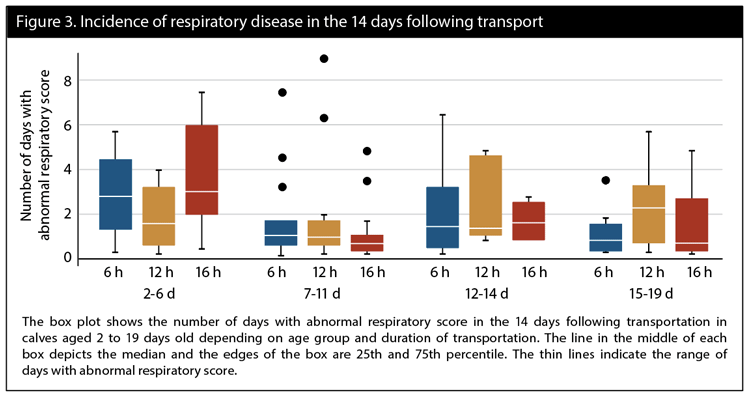Transportation can be tough on young calves |
| March 27 2023 |
| By David Renaud, D.V.M. |
|
|
The impact of long-distance trucking on dairy calves may be more pronounced than you think. Calves that are not needed for milk production, defined as surplus dairy calves, are commonly sold and transported to calf-raising facilities where they are raised for veal or dairy-beef. Some replacement heifer calves are also transported to calf raisers prior to returning to the dairy farm to calve, and some of these calves travel substantial distances. Despite how commonly calves are transported, surprisingly little research has been conducted to evaluate this practice. In addition, the research that has been done has mostly focused on physiological changes, with few studies evaluating the health implications of transport. Based on the lack of research and the new transportation regulations that have recently come into effect in Canada — where calves can no longer be transported for more than 12 hours — a research project was conducted at the University of Guelph to evaluate the impact of long-distance transportation in young dairy calves. Taking a closer look In our study, we visited five commercial dairy farms in southwestern Ontario daily for two weeks prior to transportation and enrolled calves at birth. Birth weight, sex, and breed of the calf were recorded. A blood sample was also collected within 24 to 48 hours after birth to determine transfer of passive immunity (TPI) status. Additionally, HOBO data loggers were used to measure lying time beforehand, during transportation, and for three days post-transport. On the day of transportation, calves were assigned to either six, 12, or 16 hours of continuous transportation in the same gooseneck trailer. Calves were weighed, blood sampled, examined, and fed milk before loading. Space allowance was maintained by moving a sliding gate within the trailer as calves were loaded or unloaded. Upon arrival to the calf-raising facility, calves were weighed, blood sampled, and examined immediately after unloading, as well as 24, 48, and 72 hours after unloading. Blood samples were analyzed for nearly 20 parameters associated with energy status, inflammation, and acid-base disturbances. Daily health exams continued for 14 days following arrival to identify clinical signs of dehydration, diarrhea, navel inflammation, and respiratory disease. Calves were also weighed 14 and 50 days after arrival. A total of 175 male and female calves were transported across seven transport events between October 2020 and June 2021. The Holstein and dairy-beef crossbred calves ranged in age from 2 to 19 days old at the time of transport. Our findings identified two critical aspects that may exacerbate the impact of transport on young calves. Going the distance Through the project, it was found that calves transported for longer durations experienced more challenges compared to calves transported for six hours. Specifically, calves transported 16 hours had: • Higher levels of dehydration • Greater body weight loss • Increased incidence of diarrhea in the first 14 days following transportation (Figure 1) • Elevated incidence of respiratory disease in the first 14 days following transportation in 2 to 6 day old calves (Figure 2) • Less time lying on the day of transportation and more time lying in the day following transport  When comparing calves transported for 12 hours to six hours, calves traveling 12 hours had smaller differences, including a greater level of dehydration and less time lying on the day of transportation. Older was better We also found that the calf’s age at transport was an important predictor of future health and growth. Compared to calves that were 2 to 6 days old at the time of transportation, calves over 7 days old experienced higher average daily gain (ADG) in the 50 days after arrival. These calves also had a reduced incidence of respiratory disease. In addition, compared to calves 2 to 6 days old, calves 15 to 19 days old at transport had a lower incidence of diarrhea. Calves transported between 12 to 14 and 15 to 19 days old had reduced odds of navel inflammation in the 14 days after arrival. In addition, calves transported between 2 to 5 days old spent more time lying down during transport and on the days after transport compared to calves that were 6 to 19 days old at transport. Prepare for transportation Our findings suggest that long-distance transportation results in suppression of the immune system, and the risk of health and growth challenges following transport rises with transport duration. Transporting calves at an older age may provide an opportunity to mitigate the impact of long-distance transportation. So, if calves must be transported for long distances, they should be as old as possible when they leave the farm and preferably over 1 week old for transportation of any distance.  Additionally, calves transported for a longer duration experienced more clinical signs of dehydration and mobilization of energy stores, highlighting the importance of giving calves a milk meal prior to loading to provide them with the energy necessary for a long journey. Furthermore, ensuring that calves receive sufficient, high-quality colostrum to achieve successful transfer of passive immunity is crucial for future health of calves. This research shows that transportation for long distances and at less than 1 week of age are associated with poor health and growth outcomes in dairy calves. It is beneficial if calves are retained on the source farm for as long as possible prior to transport and that they arrive at their destination quickly to alleviate transport-related stress. Looking at the bigger picture, these measures will help reduce antimicrobial use and improve calf well-being in the veal, dairy beef, and dairy industries. |
